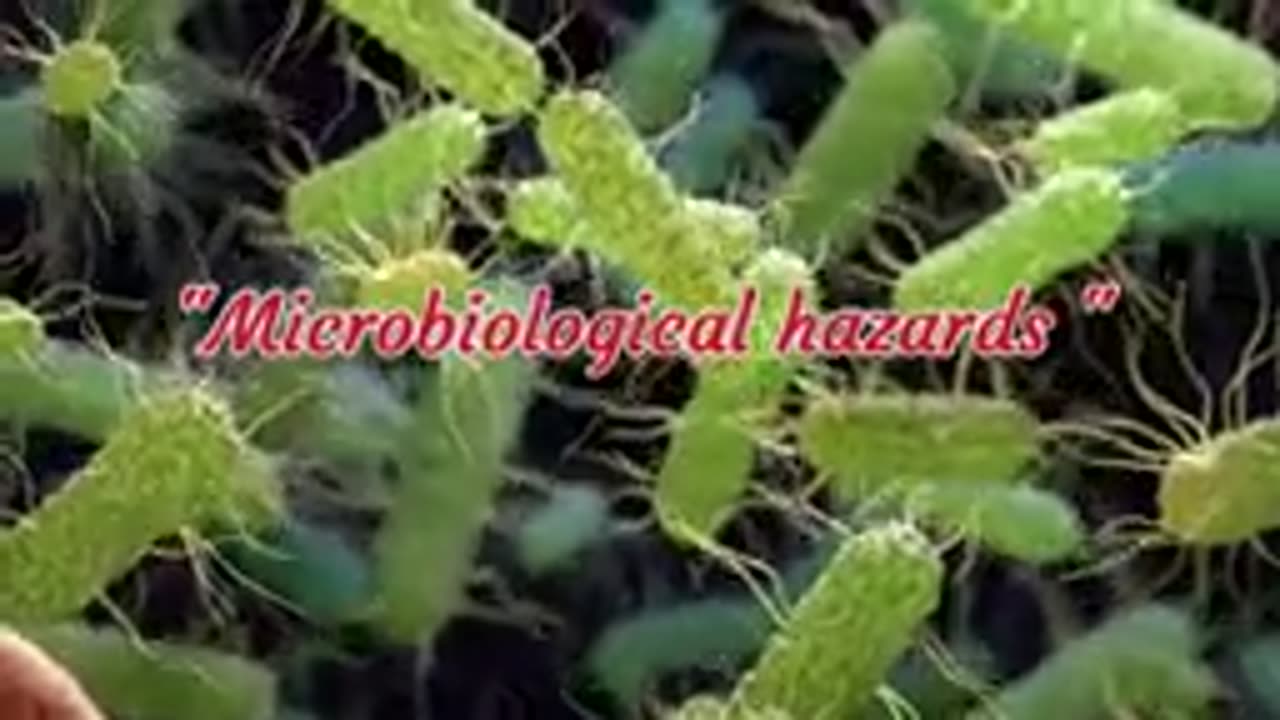Premium Only Content

Types of Hazards in Food Safety
In food safety, hazards are classified into three main categories, based on their origin and impact on human health:
---
### **1. Biological Hazards**
These involve microorganisms that can cause illness or spoilage.
**Examples:**
- **Bacteria:** *Salmonella*, *E. coli*, *Listeria*, *Clostridium botulinum*.
- **Viruses:** Norovirus, Hepatitis A.
- **Parasites:** Giardia, Toxoplasma, Cryptosporidium.
- **Fungi:** Molds and yeasts that produce toxins (e.g., aflatoxins).
**Sources:**
- Contaminated water or raw foods like meat, seafood, and dairy.
- Poor hygiene during food handling.
---
### **2. Chemical Hazards**
These include harmful substances that may contaminate food during production, processing, or handling.
**Examples:**
- **Naturally occurring toxins:** Mycotoxins, shellfish toxins, cyanogenic glycosides.
- **Added chemicals:** Pesticides, herbicides, and veterinary drugs.
- **Processing contaminants:** Acrylamide (from high-temperature cooking), BPA from packaging.
- **Allergens:** Residual allergens like peanuts, gluten, or milk proteins.
**Sources:**
- Improper use of cleaning agents or food additives.
- Contaminated soil or water.
---
### **3. Physical Hazards**
These involve foreign objects in food that can cause injury or harm.
**Examples:**
- Glass shards, metal fragments, stones, plastic pieces, hair, or bones.
**Sources:**
- Poorly maintained equipment.
- Contamination during processing, storage, or handling.
---
### **How to Control Hazards**
- **Biological:** Maintain proper hygiene, cook food to safe temperatures, refrigerate promptly.
- **Chemical:** Follow regulations for food additives, pesticide use, and storage conditions.
- **Physical:** Inspect raw materials, use protective packaging, and maintain equipment.
Hazard identification and control are vital parts of food safety systems like HACCP (Hazard Analysis and Critical Control Points).
-
 6:43
6:43
HSESafetyInformation
6 months agoLahori Chanay Recipe - Lahori Cholay Recipe - Chana Chana Masala
55 -
 LIVE
LIVE
The White House
3 hours agoPresident Trump Participates in a Cabinet Meeting, Aug. 26, 2025
2,756 watching -
 LIVE
LIVE
Rebel News
41 minutes agoCarney's flawed LNG deal, Libs keep mass immigration, Poilievre's plan to fix it | Rebel Roundup
229 watching -
 LIVE
LIVE
Side Scrollers Podcast
2 hours agoINSANE Illegal Migrant Propaganda Xbox Game + Paypal REFUSES To Pay Dev + More | Side Scrollers
268 watching -
 27:39
27:39
Crypto.com
3 hours ago2025 Live AMA with Kris Marszalek, Co-Founder & CEO of Crypto.com
39.7K3 -
 LIVE
LIVE
TheAlecLaceShow
1 hour agoMAGA Pushback Against Flag Burning EO & 600K Chinese Students | Cashless Bail | The Alec Lace Show
70 watching -
 1:09:18
1:09:18
SGT Report
15 hours agoBIOHACKING 101: MAKING BIG PHARMA IRRELEVANT -- Dr. Diane Kazer
21.5K18 -
 LIVE
LIVE
JuicyJohns
4 hours ago $1.35 earned🟢#1 REBIRTH PLAYER 10.2+ KD🟢
111 watching -
 LIVE
LIVE
The Mel K Show
1 hour agoMORNINGS WITH MEL K - The Future of the Constitutional Republic: Local Action for National Impact 8-26-25
694 watching -
 LIVE
LIVE
The Shannon Joy Show
3 hours ago🔥🔥TACO Trump Rug Pulls AGAIN - Deploying His Fascist Police State In Red States NOT Blue.🔥🔥
202 watching